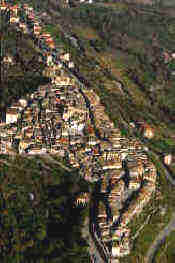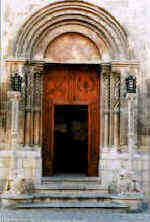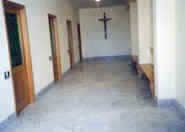|
Comment of
P. H. Pfeiffer
From Jerusalem
to Rome
Paranormalogy
and the Holy Face of Manoppello
“VERONICA”
and the Holy Shroud
|
|
Historical short essay on Manoppello |

Manoppello:
bird's-eye view |
Wrapped as in a niche by the shade of green of its hills and by
the snow-covered top of its mountain Maiella, m. 217 above
sea-level, Manoppello lies in a geographic zone very suitable to
reach in a short time both the sea-places and the mountain places.
The coat-of-arms of Manoppello includes a wheatsheaf, the "manoppio"
from which the name of this attractive small town (about 6,000
inhabitns) derives. During the roman era Manoppello was "Pollitrio".
In the XIII century the town passed to Frederick II, then from
Louis of Anjou it passed to Louis of Savoy. It was also a
possession of the Orsini family; in 1423 it was conquered and
destroyed by Braccio da Montone. The church of San Nicola di Bari
dates from the first half of the XIV century; today it displays
many Baroque features. The church of Santa Maria D'Arabona, built
in 1208, stands on the site of a Roman temple of Bonae. From the
Cistercians who built it, it passed to the conventual minor friars
and then to the Salesians.
|
|
A diploma of the Emperor
Ludovic II of the year 874 (deed of gift of the Manoppello castle
to the abbey of San Clemente a Casauria) establishes the
foundation of the town which, from the beginning of its history,
was subjected to the monastery of Montecassino. When,
in 1638, the Capuchins came into possession of the Holy Face,
Father Donato da Bomba wrote a “relatione historica”, kept in
the provincial archives of the Capuchins in L’Aquila. In it is
explained how the Holy Face arrived at Manoppello and was owned by
the friars. Let’s read the
following statement of the “relatione historica”: “In
the times of Iulius II, Roman Pontifex, lived at Manoppello, in
Hither Abruzzi, province in the kingdom of Naples, Giacomo Antonio
Leonelli phisicist and very famous in astrology and other liberal
arts. One
day he was talking with other notables of the place in the open
space in front of the mother church dedicated to St. Nicolas of
Bari; right in the middle of the conversation an unknown pilgrim
arrived, religious looking and very venerable who, greeted a so
important circle of citizens, told doctor Giacomo Antonio Leonelli,
politely and humanely, he had to confide a secret very liking,
helpful and profitable to him. Then he drew him aside, to the
threshold of the church, gave him a bundle and, without unrolling
it, told him to like very much that devotion to receive divine
benevolence and to prosper in secular and spiritual interests. |
|

The portal of the
mother church
|
Giacomo
Antonio took the bundle and, retired near the holy water stoup,
began to open it. As he saw the Holy Face, he was greatly astonished
at first sight and he burst into tears of joy then wiped so that his
friends couldn’t notice his emotion. Giving
thanks to God for such an inestimable
gift, he re-wrapped the sheet and than he looked for the unknown
pilgrim to thank him and to give him hospitality but he couldn’t
find him. Frightened, nearly stammering, he requested information
of his friends who declared they saw him going into the church but
they didn’t see him going out. Then he went back home with his
friends full of extreme gaiety and all kinds of people at Manoppello
flocked to admire such a wonderful miracle. To
revere such a marvellous and holy image and, as much as possible, to
be thankful to God for the received
benefit Doctor |
|
Giacomo
Antonio immediately had done, in the wall of his study, a niche,
wardrobe-shaped, with its well adapted little doors and keys, where he kept the Image
devoutly and respectfully and with an oil-lamp always burning
night and day.
Later on some descendants wanted to share out Giacomo Antonio’s
property received by inhereditance but a great discussion rose from
this, so a certain soldier and man at arms named Pancrazio Petrucci
(who had married Marzia, still alive, descendant of the Leonelli) on
the pretext to vindicate his wife’s rights, rushed into the
Leonelli’s house and took the Holy Image he wanted to possess. But
Pancrazio didn’t keep it with the due devotion and decorum. After
having taken it, he didn’t fold back the Image with the due
diligence and devotion but, ill-used and badly folded back, he took
it home where he kept it with not much care and
estimation.Notwithstanding this it remained fine and intact even
though wringled and spoilt and this event certainly displeased God.
But as the earthly things are more changeable than the moon, the
above-mentioned Pancrazio, who stole the Holy Image, was put into
prison by the royal court in Chieti so he wrote to his wife Marzia
to sell or to pawn whatever home object, particularly the Holy Image
as he knew that very many people wanted it and to send him money for
his release from prison. Therefore the kind and simple woman
went to Doctor Donato Antonio
De Fabritiis, another villager of Manoppello (a
man endowed with religious devotion not less than Giacomo Antonio
Leonelli) to sell him or to give him in pawn (till the return of her
husband) the Holy Image. Doctor Donato Antonio De Fabritiis wishing
for a treasure so great and precious, gave the woman four scudi (nearly
twenty liras as it happened in 1618) and took the Holy Image without
observing it or unrolling it.
Then the woman went away with the four scudi and Donato Antonio,
dispatched his business he had to attend to, good-humoured and
joyful for the beautiful purchase, spread out the Image which was in
the middle of a square veil and all transparent owing to the
thinness of the texture, four palms wide in every side and he
realized that the veil, badly kept and preserved after the
theft in Leonelli’s house, was entirely ragged, worn-out,
moth-eaten and worm-eaten, all corrupt, almost pulverized and the
last rags still hanging could fall down without being touched with
the exception of the Holy Image still beautiful, uninjured and
without deterioration, though very wrinkled.
At
first sight the spiritual merchant was astonished and regretted
spending 4 scudi for a thing very polluted and badly kept. So
putting it aside as useless and of no value thing, the doctor
thought to return it to the woman who made fun of him and to get his
money back.
Absorbed in thought, he met the President of the friary of the
Fathers Capuchins, at that time with its vestry-board at Manoppello:
Father Clemente of Castelvecchio Sacerdote, a very wise and
shrewd person, to whom he revealed his intention to give back the
Veil to recover his money.
Father Clemente heard the matter, then affected at the sight of the
beauty and the quality of the image, he knelt down, adored it and
efficaciously exhorted Donato Antonio not to give it back, on the
contrary to give much more money by request because there is no high
price in the world sufficient to pay it and he added it was a
miracle and a gift of Providence if the Veil remained in a good
state. Thanks to this sound and spiritual advice, the doctor became
calm and satisfied because he valued he had underestimated the Veil.
Therefore the same Father Clemente scissored all the rags around the
Veil and removing very well from it dust, worms and other impurities,
he turned it as it is nowadays.
The above-mentioned Donato Antonio, wishing to enjoy the Holy Image
with better devotion, got it stretched in a frame with plate-glasses
in both sides and adorned with walnut inlay by a friar of ours named
Brother Remigio of Rapino (as he did not confide in other secular
artisans).
As merciful and zealous doctor Donato Antonio considered the Holy
Image had to remain more decorously in a devoted church, not
resisting this celestial and divine impulse (not listening to the
insistent requirements of clergy and other monks of the same
territory) gave it to our convent of the Capuchins at Manoppello
where it is venerated by that people with satisfaction of those
Brothers who never get tired of revering it.
Continuation
of the story.
The convent of the Capuchins was founded from 1618 to 1620, exactly
when Giacomo Antonio De Filippis had the Holy Veil put between two
plate-glasses. The church was
dedicated to St. Michael Archangel. In this church the Holy Face was
exposed to the veneration of the people on April 6th, 1646. For
nearly 40 years it was not object of public veneration but kept
almost privately in a niche, in the right-hand side of the high
altar.
Only
in 1686 was built, in the left-hand of the church, a little chapel
with an altar where the sacred relic was moved and was brought the
liturgic feast of August 6th, day of the Transfiguration of Christ
on the Mount. A negative event
increased the veneration for the Holy Face. The eighteenth century
started with a lustrum of earthquake shocks which shook incessantly
Umbria, Abruzzo and Sannite region. Father Boniface of Ascoli from
1703 exposed many times the Holy face to the popular veneration.
The XIX century was marked by laws of suppression of religious
orders: the monks had to leave the convent twice; the first time on
September 6th, 1811; the same day the Holy Face was transferred to
the Clarisse convent situated within the walls. The convent remained
uninhabited, the sanctuary closed up to May 16th , 1816 when the
Capuchins returned. The following Sunday, celebrated the usual feast,
the Sacred Veil was taken back in triumph to its sanctuary.
|
|

Confessional room
|
But on
December 27th , 1866 a law expelled again the friars from the
coenobium; the Holy Face remained inside the closed sanctuary. The
monks returned on October 27th , 1869 and remained there till to-day.
In 1871 was finished the new
chapel. In 1923 was built the shrine on the high altar. In 1946 the
community of Manoppello gave the new shrine. The
church was enlarged and extended in the second post-war period from
1960 to 1965. The confessional room was built in the jubilee year
2000. |
|
"I am the light of the world. He who follow me, will
not walk in darkness but will have the light of life". (John
8, 12) |
|
|